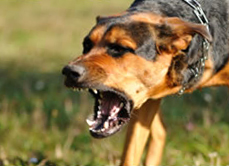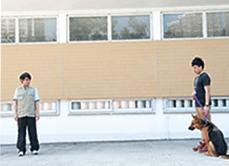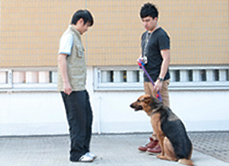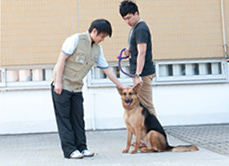Dogs
Dogs
Protocol for Assessing Aggression in Dogs by Veterinarians
Principles
The protocol provides guidelines for the assessment of temperament in dogs. Other criteria including health should be assessed when the dogs are being considered for sale or adoption from pounds and shelters. A dangerous dog is generally defined as one which threatens the safety of people and other animals by showing aggression with little or no provocation.
Aggression is here taken to mean over behaviour involving intent to inflict damage. Dog aggression may be shown by one or more of the following:
- growling,
- barking,
- snapping,
- biting,
- jumping or
- rushing towards a person or dog with teeth bared.

Most dogs are capable of aggression given sufficient challenge. In judging whether a dog is likely to be dangerous the degree of challenge to which that animal is exposed must be considered.
Behaviour may be influenced by genetic predisposition, experience (such as primary socialisation and other learning), the present environment and the dog handler.
There are many recognised types of aggression, though dominance and fear are the two most likely to be encountered in an examination. Dogs should be assessed for aggression at the same time as they are given a physical examination. A physical examination necessitates the dog accepting authority and physical control.
Assessment Criteria
Any assessment of aggression is partly subjective, although consideration of the following will make the examination more objective. In each instance
- is acceptable,
- is borderline,
- is unacceptable.
1.How does the animal react at the sight of an unfamiliar person?
- It shows little reaction or shows sociable behaviour.
- It growls and barks.
- It is overly aggressive.

2. On being approached by an unfamiliar person, how does the animal react?
- It shows little interest.
- It withdraws.
- It exhibits aggression.

3. How does the dog react when a hand is passed from the top of the head, to the neck and between the shoulder blades?
- It shows little response or reacts submissively.
- It moves away.
- It becomes aggressive.

4. During a full clinical examination the veterinarian should be able to examine an animal from head to tail. How does the dog respond?
- It readily submits to examination.
- It is uncooperative.
- It becomes aggressive.
5. How does the dog react when the veterinarian attempts to examine its mouth?
- It does not resist.
- It attempts to turn and face the person.
- It becomes aggressive.
6. How does the dog react when approached from the rear?
- It stands and allows handling.
- It attempts to turn and face the person.
- It becomes aggressive.
7. How does the dog react when a hand is passed from the top of the head, to the neck and between the shoulder blades?
- It does not resist.
- It resists by sitting or turning.
- It becomes aggressive.
8. When prolonged eye contact is established between the veterinarian and the animal, how does the animal respond?
- It averts its eye.
- It maintains eye contact with no result or exhibits fear.
- It becomes aggressive.